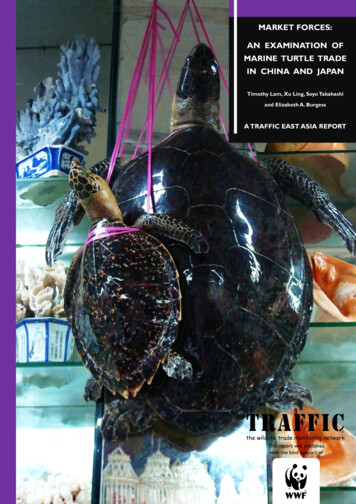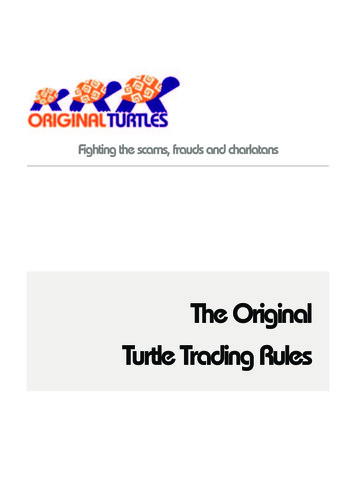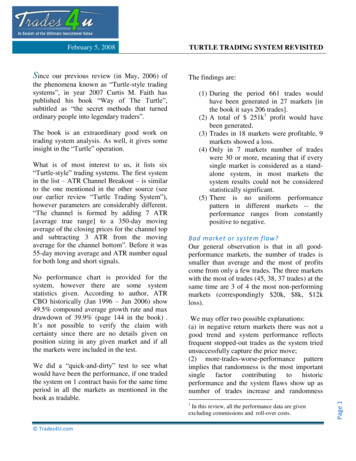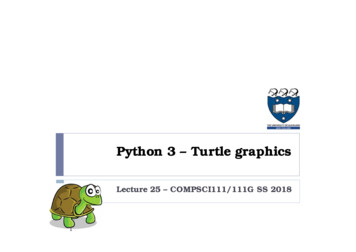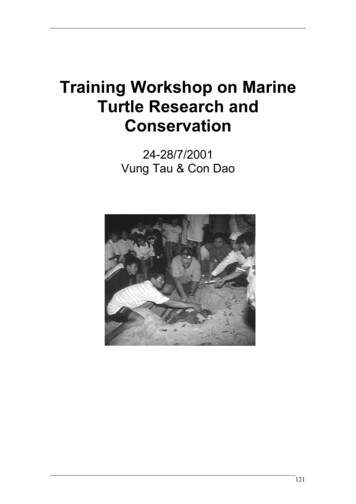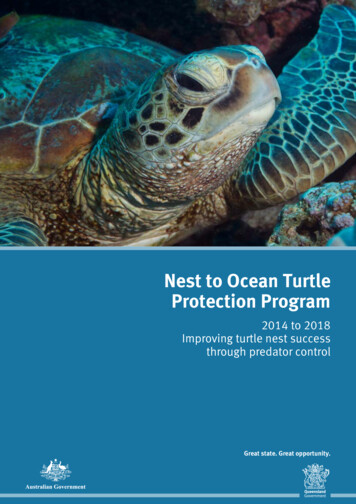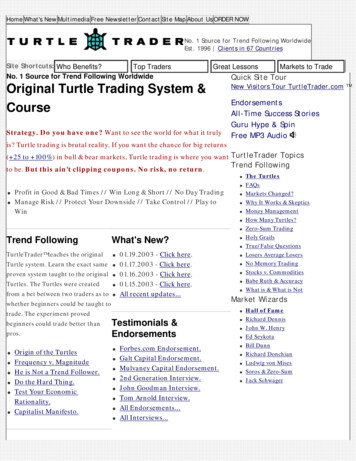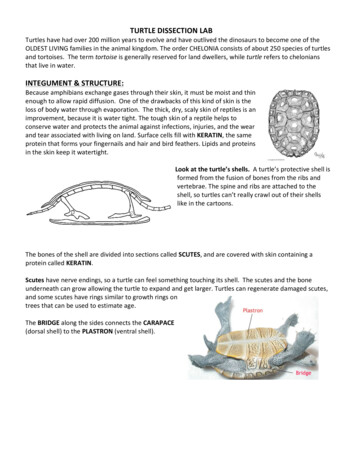
Transcription
TURTLE DISSECTION LABTurtles have had over 200 million years to evolve and have outlived the dinosaurs to become one of theOLDEST LIVING families in the animal kingdom. The order CHELONIA consists of about 250 species of turtlesand tortoises. The term tortoise is generally reserved for land dwellers, while turtle refers to cheloniansthat live in water.INTEGUMENT & STRUCTURE:Because amphibians exchange gases through their skin, it must be moist and thinenough to allow rapid diffusion. One of the drawbacks of this kind of skin is theloss of body water through evaporation. The thick, dry, scaly skin of reptiles is animprovement, because it is water tight. The tough skin of a reptile helps toconserve water and protects the animal against infections, injuries, and the wearand tear associated with living on land. Surface cells fill with KERATIN, the sameprotein that forms your fingernails and hair and bird feathers. Lipids and proteinsin the skin keep it watertight.Look at the turtle’s shells. A turtle’s protective shell isformed from the fusion of bones from the ribs andvertebrae. The spine and ribs are attached to theshell, so turtles can’t really crawl out of their shellslike in the cartoons.The bones of the shell are divided into sections called SCUTES, and are covered with skin containing aprotein called KERATIN.Scutes have nerve endings, so a turtle can feel something touching its shell. The scutes and the boneunderneath can grow allowing the turtle to expand and get larger. Turtles can regenerate damaged scutes,and some scutes have rings similar to growth rings ontrees that can be used to estimate age.The BRIDGE along the sides connects the CARAPACE(dorsal shell) to the PLASTRON (ventral shell).
Reptiles have an unusual stance not seen in other animal groups. Theirlimbs protrude at right angles from their bodies.In all other animals with arms and legs, the shoulders and pelvic bones areOUTSIDE THE RIBCAGE.In turtles the skeleton is modified so the LIMB GIRDLES (shoulders andpelvis) are located INSIDE THE RIBCAGE.This allows the turtle to pull its limbs inside its shell.TEMPERATURE REGULATION:Reptiles are ECTOTHERMIC, commonly called “cold blooded”. They don’t make their own body heat. Theymaintain their body temperature (THERMOREGULATION) by absorbing heat from their environment. Whenit gets too warm they find a cool, shady spot. When they get too cool, they warm themselves by basking inthe sun.ADVANTAGES OF BEING ECTOTHERMIC:(1) ECTOTHERMS require very little energy because their metabolism is so low.(2) Because their metabolism is so slow, ectotherms can survive on about 1/10 the amount of foodneeded by the same size endotherm (warm blooded organism).DISADVANTAGES OF BEING ECTOTHERMIC:1) Ectotherms can run or swim at MAXIMUM SPEED FOR ONLY SHORT PERIODS of time. (Theirmetabolism can’t provide enough energy to keep them going longer.)2). Ectotherms CAN’T LIVE IN VERY COLD CLIMATES. They survive in moderate climates only bybecoming dormant (HIBERNATING) during the coldest months.Because their body temperature is dependant on the temperature of their environment, reptiles areabundant in the warmer regions of the world, a few live in colder parts of the temperate zone, but nonelive in the Arctic or Antarctic regions.
EXTERNAL FEATURES:(1) Locate the exit opening below the turtle’s tail. Like amphibians, the CLOACA, a multipurpose cavity shared by thedigestive, reproductive, and excretory systems exits through a VENT.(2) Look at the feet of the turtle. One of the characteristics you saw in amphibians(mudpuppy) was feet with NO CLAWS. Notice the CLAWED FEET in reptiles. Manyreptiles have feet with claws, but remember some like snakes do not.(3) Look at the eyes. Like frogs,turtles have a NICTITATINGMEMBRANE that acts as a third eyelid to cover and protect theeyeball under water.(4) Look behind the eyes for the “ears”. The TYMPANICMEMBRANE (eardrum) is directly behind the eyes. Turtleshave very poor hearing.(5) Look at the nose. The EXTERNAL NARES (nostrils) connect inside to the mouth just like in amphibians. TwoINTERNAL NARES (connect to EXTERNAL NARES outside) which allow the turtle to breathe with its mouth closed.(6) Open the mouth. Unlike other reptiles, turtles have NO TEETH. Instead they have a sharp BEAK made ofKERATIN. The mouth in a turtle is very similar to that seen in amphibians. The GLOTTIS, a vertical slit just behindthe TONGUE, is the opening to the respiratory system. Behind the glottis is the GULLET (the opening into thedigestive system).What sex is it?Male turtles have longer front claws and a longer tail.The vent in males is farther back from the edge of theirshell than in females. Their plastron is slightly concave toallow for males to climb on top of females during mating.The plastron in a female is slightly convex to allow moreroom for eggs inside.
INTERNAL DISSECTION INSTRUCTIONS: REMOVE your PLASTRON:Examine the carapace and the plastron of the shell. The plastron will have to be removed in the mountedskeleton. Removing the shell is a very difficult and time consuming procedure. It will give you anappreciation of the armor that protects the turtle from most predators and which partially accounts for thelong lives that turtles live.Go slow and BE CAREFUL! Be sure and not injure yourself or your lab partner while removing the shell. DONOT USE YOUR SCALPEL TO PRY OPEN THE SHELL . . . it will break.Use the saw and the bone cutters to remove the plastron. There is only 2 saws to share for the entire classso be patient. Disconnect the skin around the legs to separate it from the shell. This is a difficult and timeconsuming procedure! It will give you an appreciation for the armor that protects the turtle from mostpredators and which partially accounts for the long lives that turtles live.Many tough membranes also attach the carapace and plastron and these membranes need to be cut with arazor blade or scalpel. After these incisions have been made, you should be able to completely remove theplastron and all of the internal organs should be visible in the carapace.Reptiles are EUCOELOMATES. The space you see surrounding the internal organs is “true coelom” (bodycavity lined on both sides by mesoderm).The yellowish structures are stored FAT. Turtles do not store fat in the same way as frogs do. Fat stores arereservoirs for food used during HIBERNATION.The MESENTERY (fan-like membrane) connects the internal organs just like in a frog.
DIGESTIVE:(1) Just like in a frog, food moves from PHARYNX (back of throat) down the GULLET into the ESOPHAGUSto the STOMACH. Acid secreted by the walls of the stomach and the stomach muscles work to breakdown food. The esophagus is a muscular structure BEHIND the TRACHEA which is the “windpipe” forthe true lung breathers. Make sure you can locate all these bold terms.(2) The PYLORIC SPHINCTER muscle at the end of the stomach controls the passing of digested food intothe SMALL INTESTINE. At the bottom of the stomach you will see a pinching like a narrowing this is thepyloric sphincter. Make sure you can locate the terms in bold.(3) The upper portion of the SMALL INTESTINE closest to the stomach is the DUODENUM. The next coiledsection is the ILEUM. A fan-like membrane called the MESENTERY holds the folds of the small intestinetogether. The small intestine receives bile from the liver and pancreatic enzymes (including trypsin)from the pancreas. Digestion is completed here and nutrients are absorbed through the villi (smallfingerlike extensions) lining the small intestine. Make sure you can locate the terms in bold.(4) The lower end of the small intestine leads into the LARGE INTESTINE (also called the COLON), whereundigested waste is collected and passed into the CLOACA, a multipurpose cavity. Make sure you canlocate the terms in bold.(5) Digestive waste, nitrogen waste from the KIDNEYS’S (urine), as well as eggs and sperm all pass throughthe CLOACA on their way out of the body through the VENT. Make sure you can locate the terms inbold.(6) Locate the LIVER. The main functions of the lobed LIVER are to MAKE BILE, STORE GLYCOGEN andVITAMINS, and PROCESS TOXINS including NITROGEN WASTE for the kidneys to remove.(7) Locate the GALL BLADDER, a greenish colored sac found in the liver, stores BILE made by the LIVER.(8) Locate the PANCREAS is an elongated organ located in the first loop of intestine between the beginningof the small intestine and stomach. It secretes TRYPSIN that is used in the small intestine to break downproteins.RESPIRATION:(1) Turtles use LUNGS for respiration. Air enters the GLOTTIS, moves down the TRACHEA (a tube lined withcartilage rings which help to hold the airway open) which splits into two BRONCHI that carry air into thelungs. Unlike a frog whose lungs were simple sacs, the lungs in a turtle have many small individual airsacs called ALVEOLI (sing. ALVEOLUS) to increase surface area for greater gas exchange. Some seaturtles can exchange gases through the skin of their cloaca.CIRCULATORY:Like amphibians, the circulatory system in reptiles consists of a CLOSED TWO LOOP SYSTEM and a THREECHAMBER HEART surrounded by a PERICARDIAL MEMBRANE.(1) Locate the RIGHT ATRIUM, LEFT ATRIUM, and VENTRICLE. Look for the SINUS VENOSUS and CONUSARTERIOSUS. The CONUS ARTERIOSUS forms the base of the 3 large arteries leaving the heart.
The PULMONARY CIRCULATION carries deoxygenated blood from the heart to the lungs, then returnsoxygenated blood to the heart. The SYSTEMIC CIRCULATION carries oxygenated blood from the heart tothe muscles and body organs and brings deoxygenated blood back to the heart. Remember adding asecond loop has the advantages of FASTER BLOOD FLOW to the body organs and MORE EFFICIENT deliveryof oxygen.Low oxygen blood returning from the body enters the SINUS VENOSUS. Fromthere it enters the RIGHT ATRIUM. At the same time high oxygen blood returningfrom the lungs enters the LEFT ATRIUM. When the atria contract, both kinds ofblood are sent to the VENTRICLE. The turtle heart is different from that seen infrogs. In most reptiles a PARTIAL SEPTUM appears to separate the ventricle tofurther prevent mixing to the HIGH and LOW oxygen blood that shares thispumping chamber. (In Crocodilians this septum divider is complete makingcrocodilians the only reptiles with a 4 chamber heart.) When the ventriclecontracts, both kinds of blood pass through the CONUS ARTERIOSUS, which has avalve to prevent mixing of high and low oxygen blood. Large arteries then carrythe high oxygen blood out to the body organs and muscles and low oxygen blood issent to the lungs to pick up oxygen.to conserve energy.**The reptile circulatory system has a flexibility that amphibians, birds, andmammals do not. Pumping blood through the lungs requires energy. Under somecircumstances it is advantageous for a reptile to divert blood away from the lungsThere are times when a reptile may want to save energy by bypassing the lungs1. when it is inactive (may go a long time without breathing)2. when holding breath underwater3. when they want to warm up fastBy constricting the blood flow to the pulmonary arteries, a reptile can redirect blood to the body andbypass (SKIP) the lungs to save energy. Bypassing the lungs can also help a reptile raise its bodytemperature quickly because warm blood from the skin can be directed to the organs deep inside.EXCRETORYThe excretory system of reptiles helps them to conserve body water. Snakes, lizards, and other landdwelling reptiles excrete nitrogen waste in the form of URIC ACID. Unlike amphibians that excrete urea,uric acid is must less toxic (poisonous) so it requires little water for dilution. Reptiles lose only smallamounts of water in their urine.(1) Locate the KIDNEYS. They lie on either side of the spine against the dorsal body wall, are the primaryexcretory organs. The kidneys filter NITROGEN WASTES (URIC ACID) from the blood, and dilute it withwater to make URINE. The kidneys also REGULATE THE ION/WATER BALANCE in the blood and tissues.(2) The URINARY BLADDER is a transparent sac near the cloaca which stores urine until it is releasedthrough the VENT. Urine flows from the kidneys through urinary ducts to the CLOACA.REPRODUCTIONFertilization in turtles is INTERNAL. The reproductive pattern seen in turtles and tortoises is OVIPARITY.The female scoops out a hole with her hind legs, deposits the eggs, and covers the nest. Most species of
reptiles provide no care for their eggs or young. Marine turtles often migrate long distances to lay theireggs on the same beach where they hatched. Reptiles, including turtles, have direct development. Babyturtles hatch from their eggs looking like miniature adults.Females: A female turtle has paired OVARIES that produce the eggs, which pass through the OVIDUCTS,and passed out via the CLOACA through the VENT. The female’s reproductive tract encloses each egg in atough protective shell as it passes through the OVIDUCTS.Males: Males have TESTES that make the sperm which passes through tubules called VAS DEFERENS to theCLOACA and out of the body. Males have a PENIS to deposit the sperm inside the female’s body whichincreases the chances of fertilization.In most organisms, an individual’s sex is determined by the presence of X or Y chromosomes.In humans XX makes you a female, Xy makes you a male. In many reptiles, sex is determined by thetemperature at which the egg is incubated. Location OF the nest (shady or in the sun) and location IN thenest (bottom or top) determines whether the baby turtle will be a boy or girl. Some studies suggest thatfemale reptiles may put their nests in different places depending on the male: female ratio in thepopulation.Turtles lay AMNIOTIC EGGS with 4 specialized membranes, which surround the embryo in a self-containedaquatic environment. The tough shell on the outside provides more protection to the embryo inside thanthe jelly coating of an amphibian egg. The AMNIOTIC EGG is an advancement that allowed reptiles to moveout onto land and not have to return to water to lay theireggs.The diagram above shows the internal structure of such an egg. The egg is named for the AMNION the thinmembrane that encloses the developing embryo and the fluid that surrounds it; The YOLK SAC encloses theyolk, a fat-rich food source for the growing embryo; The ALLANTOIS stores nitrogen waste produced by thegrowing embryo AND exchanges gases with the environment; The CHORION surrounds all the othermembranes and helps protect the developing embryo. Protein and water needed by the embryo arecontained in the ALBUMEN.The amniotic egg first evolved in reptiles but also occurs in birds and a few mammals (like the platypus).Scientists believe this is evidence that reptiles, birds, and mammals evolved from a common ancestor.
enough to allow rapid diffusion. One of the drawbacks of this kind of skin is the loss of body water through evaporation. The thick, dry, scaly skin of reptiles is an improvement, because it is water tight. The tough skin of a reptile helps to conserve water and protects the animal against infections, injuries, and the wear
